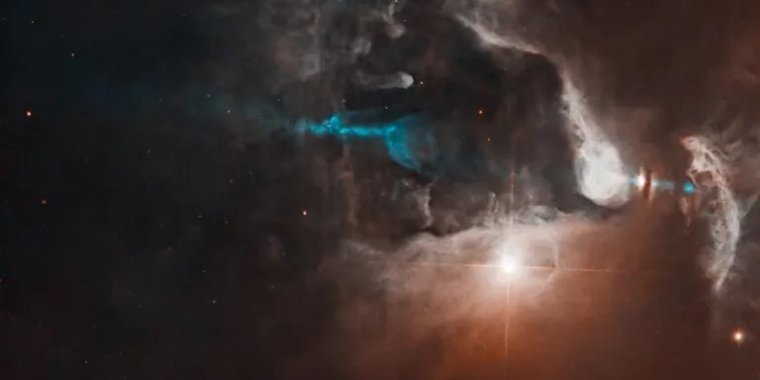| News / Space News |
Hubble Sees New Star Proclaiming Presence with Cosmic Lightshow
Jets emerge from the cocoon of a newly forming star to blast across space, slicing through the gas and dust of a shining nebula in this new image from NASA’s Hubble Space Telescope.

This new image from NASA’s Hubble Space Telescope features the FS Tau star system. Photo: NASA, ESA, and K. Stapelfeldt (NASA JPL); Image Processing: Gladys Kober (NASA/Catholic University of America)
FS Tau is a multi-star system made up of FS Tau A, the bright star-like object near the middle of the image, and FS Tau B (Haro 6-5B), the bright object to the far right obscured by a dark, vertical lane of dust.
The young objects are surrounded by gently illuminated gas and dust of this stellar nursery. The system is only about 2.8 million years old, very young for a star system. Our Sun, by contrast, is about 4.6 billion years old.
FS Tau B is a newly forming star, or protostar, surrounded by a protoplanetary disk, a pancake-shaped collection of dust and gas leftover from the formation of the star that will eventually coalesce into planets.
The thick dust lane, seen nearly edge-on, separates what are thought to be the illuminated surfaces of the flared disk.
FS Tau B is likely in the process of becoming a T Tauri star, a type of young variable star that hasn’t begun nuclear fusion yet but is beginning to evolve into a hydrogen-fueled star similar to our Sun.
Protostars shine with the heat energy released as the gas clouds from which they are forming collapse, and from the accretion of material from nearby gas and dust. Variable stars are a class of star whose brightness changes noticeably over time.
FS Tau A is itself a T Tauri binary system, consisting of two stars orbiting each other.
Protostars are known to eject fast-moving, column-like streams of energized material called jets, and FS Tau B provides a striking example of this phenomenon.
The protostar is the source of an unusual asymmetric, double-sided jet, visible here in blue. Its asymmetrical structure may result from the difference in the rates at which mass is being expelled from the object.
FS Tau B is also classified as a Herbig-Haro object. Herbig–Haro objects form when jets of ionized gas ejected by a young star collide with nearby clouds of gas and dust at high speeds, creating bright patches of nebulosity.
FS Tau is part of the Taurus-Auriga region, a collection of dark molecular clouds that are home to numerous newly forming and young stars, roughly 450 light-years away in the constellations of Taurus and Auriga.
Hubble has previously observed this region, whose star-forming activity makes it a compelling target for astronomers. Hubble took these observations as part of an investigation of edge-on dust disks around young stellar objects.
YOU MAY ALSO LIKE





